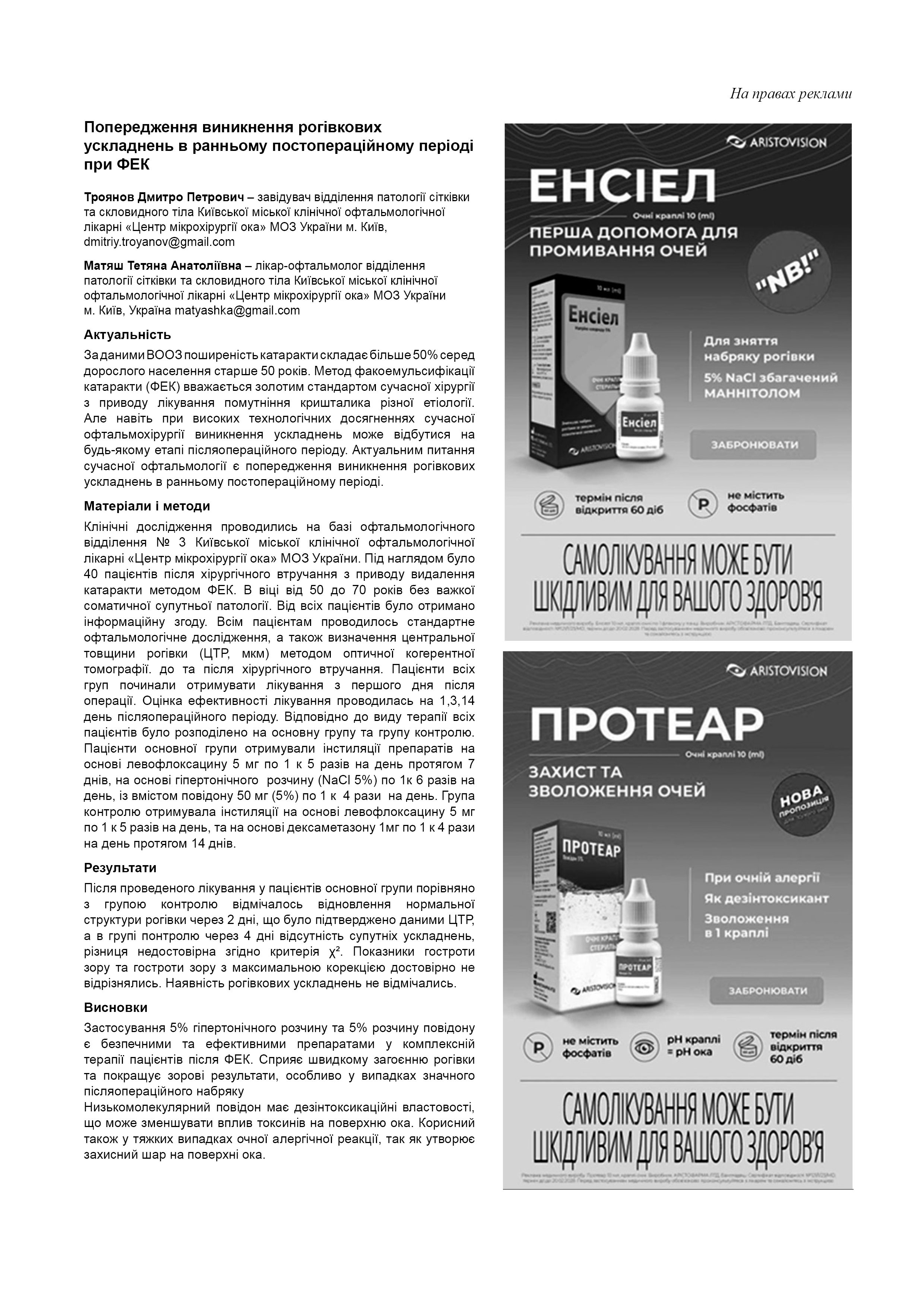Prospects for predicting long-term treatment outcomes in patients with combat ocular trauma
DOI:
https://doi.org/10.31288/oftalmolzh202333437Keywords:
combat eye trauma, results prediction, Ocular Trauma ScoreAbstract
Introduction. The analysis of experience in changing approaches to organizing medical care for combat eye injuries, changing treatment tactics for such patients during armed conflicts in the 20th and 21st centuries, domestic experience in providing medical care for eye and its adnexal injuries, highlights the search for informative methods of predicting long-term outcomes of the applied treatment methods.
The aim of the study was to determine the informativeness of constructing a forecast of functional changes of the visual analyzer based on the results of treatment of patients with eye injuries during dynamic retrospective observation.
Materials and Methods: The primary material for the study was medical documentation of combat eye injury patients (data from medical histories, outpatient cards, and discharge summaries) for the period of 2014-2015, who were treated at the National Military Medical Clinical Center "Main Military Clinical Hospital" (NMMCC "MMCH"). Indicators of the functional state of the visual analyzer were evaluated upon admission to the NMMCC "MMCH" and after 180 days following the injury. The study used the proposed F. Kuhn and colleagues' scale for evaluating long-term treatment outcomes (OTS-Ocular Trauma Score).
Results. It was found that overall, the results of treatment for combat eye injuries and their adnexa at the NMMCC "MMCH" during the study period of 2014-2015 showed a high correlation with the calculated values of the probability of preserving visual functions according to the OTS scale. Almost all patients with a case of blindness remained blind in the injured eye six months later. In the group with light projection and movement of the hand near the face, an improvement in visual function in most cases (65%) was noted, while, according to the OTS scale, these patients in most cases remain in this group or move to the group with blindness. Cases with visual acuity of 0.005-0.1 after 6 months improve visual acuity with the transition in most cases to 0.1 and above. The same trend, but, as expected, with a higher probability in groups with visual acuity of 0.1-0.4 and above 0.5. The identified discrepancies justify the need for adaptation of the OTS scale for predicting functional changes in combat eye injuries, as it has been developed for use in eye injuries during peacetime.
Conclusion: Considering the large number of wounded soldiers with severe eye injuries during the war with rf, scientific research on the implementation of a system for predicting long-term functional outcomes of the treatment of combat eye trauma based on clinical data at the time of initial examination remains relevant. The results obtained with the OTS (Ocular Trauma Score) assessment scale in most cases correspond to the results of the treatment of injured patients in the ophthalmology clinic of the NMMCC "MMCH" in 2014-2015. Further development of the existing OTS system and its adaptation to domestic conditions and the realities of providing ophthalmic care for combat eye trauma is promising for further study.
References
Заруцький ЯЛ, Білий ВЯ, Денисенко ВМ, Асланян АС. [Воєнно-польова хірургія: підручник]. Київ: Фенікс; 2018. Україна
Жупан ББ. Офтальмологічна допомога в медичному забезпеченні антитерористичної операції. Екстрена медицина. 2017;4(25):12-16.
Akıncıoğlu D, Küçükevcilioğlu M, Durukan A. Combat-related ocular trauma and visual outcomes during counter-terrorism urban warfare operations in Turkey. Ulus Travma Acil Cerrahi Derg. 2022; 28(5):648-653 https://doi.org/10.14744/tjtes.2021.25822
Guven S. Verification of Ocular Trauma Score for Intraocular Foreign Bodies in Lethal-Weapon-Related Ocular Injuries. Military Medicine. 2020;185(7-8):1101-1105 https://doi.org/10.1093/milmed/usaa042
Kuhn F. Ocular traumatology. Berlin: Springer; 2008. 538 с.
Kuhn F, Maisiak R, Mann, Mester V, Morris R, Witherspoon C. The Ocular Trauma Score (OTS). Ophthalmol Clin North Am. 2002; 15(2):163-165 https://doi.org/10.1016/S0896-1549(02)00007-X
Vlasov A, Ryan D, Ludlow S, Coggin A, Weichel E, Stutzman R et al. Corneal and Corneoscleral Injury in Combat Ocular Trauma from Operations Iraqi Freedom and Enduring Freedom. Military Medicine. 2017;182(1):114-119 https://doi.org/10.7205/MILMED-D-16-00041
Weichel E, Colyer M, Ludlow S, Bower K, Eiseman A. Combat Ocular Trauma Visual Outcomes during Operations Iraqi and Enduring Freedom. Ophthalmology. 2008;115(12):2235-2245. https://doi.org/10.1016/j.ophtha.2008.08.033
Downloads
Published
How to Cite
Issue
Section
License
Copyright (c) 2023 Zhupan B.B., Lurin I.A., Medvedovska N.V., Khramov I.I.

This work is licensed under a Creative Commons Attribution 4.0 International License.
This work is licensed under a Creative Commons Attribution 4.0 International (CC BY 4.0) that allows users to read, download, copy, distribute, print, search, or link to the full texts of the articles, or use them for any other lawful purpose, without asking prior permission from the publisher or the author as long as they cite the source.
COPYRIGHT NOTICE
Authors who publish in this journal agree to the following terms:
- Authors hold copyright immediately after publication of their works and retain publishing rights without any restrictions.
- The copyright commencement date complies the publication date of the issue, where the article is included in.
DEPOSIT POLICY
- Authors are permitted and encouraged to post their work online (e.g., in institutional repositories or on their website) during the editorial process, as it can lead to productive exchanges, as well as earlier and greater citation of published work.
- Authors are able to enter into separate, additional contractual arrangements for the non-exclusive distribution of the journal's published version of the work with an acknowledgement of its initial publication in this journal.
- Post-print (post-refereeing manuscript version) and publisher's PDF-version self-archiving is allowed.
- Archiving the pre-print (pre-refereeing manuscript version) not allowed.



.png)










